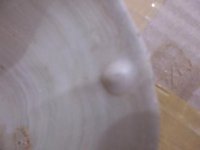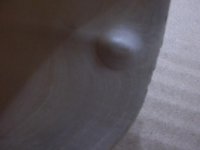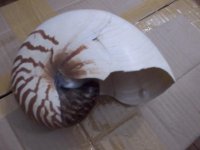You are using an out of date browser. It may not display this or other websites correctly.
You should upgrade or use an alternative browser.
You should upgrade or use an alternative browser.
Nautilus blister pearl
- Thread starter conchas
- Start date
CLICLASP
Well-known member
Wonderful, thank you for sharing this amazing found
Caitlin
Well-known member
Yowsa! Welcome! Have you read our other nautilus thread?
Please tell us where and how you found that shell with the blister pearl. It looks pretty dried out, but I think that would be of scientific interest.
Where is Steve?
I just went back and made the old nautilus thread a sticky.
Please tell us where and how you found that shell with the blister pearl. It looks pretty dried out, but I think that would be of scientific interest.
Where is Steve?
I just went back and made the old nautilus thread a sticky.
SteveM
Well-known member
- Joined
- Jan 29, 2007
- Messages
- 2,113
Thanks for the heads up, Caitlin.
That has a nice shape, vs. oblong as we have seen in the Nautilus thread in at least three examples. Those oblong shell thickenings represented reinforcement of exterior shell stress cracks. Conchas, could you take a picture of the exterior side of the shell in the precise location of the nacre thickening?
That location, near the aperture of the shell, is where the fastest columnar (gastopodal) growth of nacre occurs, prior to conversion to slower terraced (bivalval) growth towards the interior. You wouldn't expect an anomalous shell feature on this part of the shell to be anything but columnar nacre.
Await the new pictures!
That has a nice shape, vs. oblong as we have seen in the Nautilus thread in at least three examples. Those oblong shell thickenings represented reinforcement of exterior shell stress cracks. Conchas, could you take a picture of the exterior side of the shell in the precise location of the nacre thickening?
That location, near the aperture of the shell, is where the fastest columnar (gastopodal) growth of nacre occurs, prior to conversion to slower terraced (bivalval) growth towards the interior. You wouldn't expect an anomalous shell feature on this part of the shell to be anything but columnar nacre.
Await the new pictures!
Lagoon Island Pearls
Well-known member
- Joined
- Dec 8, 2009
- Messages
- 2,143
Those oblong shell thickenings represented reinforcement of exterior shell stress cracks. Conchas, could you take a picture of the exterior side of the shell in the precise location of the nacre thickening?
Await the new pictures!
Very nice find Conchas. How and where did you aquire this?
Steve, my thoughts too on additional photos as there appears to be other cracks present in this specimen.
Conchas, could you post an array of photos, targetting both sides of these cracks and any other shell abnormalities?
Yesterday we bought 1500 Nautilus shells and while selecting we found this .
I asked the guy (supplier)he has been dealing in it for quite some time we guess 2 to 3 thousand go through him monthly . if he has ever found a Nautilus pearl ( from the meat ) , he said never . Of-course that's one persons testimony .
Ive went through a few thousand ( less than 10 thou ) . The guy selecting with me over 100,000 over 10 years said its his first time seeing a blister pearl .
from our experience Nautilus shells seldom have holes maybe 1 in 50 , could be one reason for low incidence of blister pearls , but many have cracks some from handling and some natural .
We go through a few hundred MOP shells a year and so many do have multiple holes .
But this Nautilus shell doesn't have a hole on the outer side , the lines on the outer side don't seem to curve around it like it does on the inner side .
I'm a newbie when it comes to pearls so I can only talk about what we see in the sea shell world. Ive uploaded a few more pics .
I haven't finished reading the 50plus page thread on Nautilus pearls , but I'm working on it
2 pics were shot through a loupe and the paper clips are for easy reference .
I asked the guy (supplier)he has been dealing in it for quite some time we guess 2 to 3 thousand go through him monthly . if he has ever found a Nautilus pearl ( from the meat ) , he said never . Of-course that's one persons testimony .
Ive went through a few thousand ( less than 10 thou ) . The guy selecting with me over 100,000 over 10 years said its his first time seeing a blister pearl .
from our experience Nautilus shells seldom have holes maybe 1 in 50 , could be one reason for low incidence of blister pearls , but many have cracks some from handling and some natural .
We go through a few hundred MOP shells a year and so many do have multiple holes .
But this Nautilus shell doesn't have a hole on the outer side , the lines on the outer side don't seem to curve around it like it does on the inner side .
I'm a newbie when it comes to pearls so I can only talk about what we see in the sea shell world. Ive uploaded a few more pics .
I haven't finished reading the 50plus page thread on Nautilus pearls , but I'm working on it
2 pics were shot through a loupe and the paper clips are for easy reference .
Attachments
-
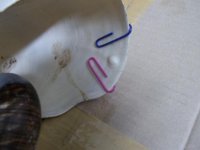 100_0084.jpg16.9 KB · Views: 183
100_0084.jpg16.9 KB · Views: 183 -
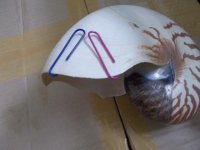 100_0115.jpg22 KB · Views: 183
100_0115.jpg22 KB · Views: 183 -
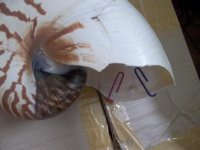 100_0114.jpg23.8 KB · Views: 189
100_0114.jpg23.8 KB · Views: 189 -
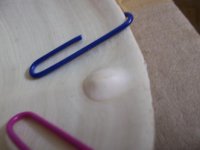 100_0101.jpg16.4 KB · Views: 193
100_0101.jpg16.4 KB · Views: 193 -
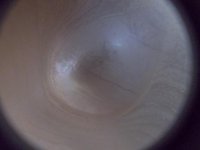 100_0117.jpg11.7 KB · Views: 182
100_0117.jpg11.7 KB · Views: 182 -
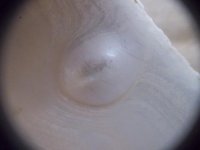 100_0119.jpg12.3 KB · Views: 179
100_0119.jpg12.3 KB · Views: 179 -
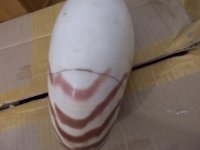 100_0126.jpg15.8 KB · Views: 185
100_0126.jpg15.8 KB · Views: 185 -
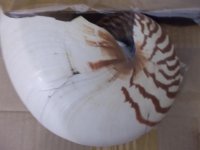 100_0128.jpg16.5 KB · Views: 199
100_0128.jpg16.5 KB · Views: 199 -
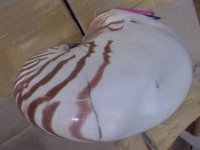 100_0127.jpg19.4 KB · Views: 191
100_0127.jpg19.4 KB · Views: 191
SteveM
Well-known member
- Joined
- Jan 29, 2007
- Messages
- 2,113
Excellent photos, the loupe shots are especially accomplished.
There is certainly an exterior shell crack at the last septum as I described in my prior post, indicating Indonesian origin, as this phenomenon has not been observed in Nautilus from elsewhere according to Nautilus biologists with whom I've consulted. It would be valuable to have confirmation of this, including the island (although the shell dealer no doubt sources from the entire archipelago and beyond). I hope this will be possible.
The 'blister' has left a trail behind it, albeit very slight, indicating that the source of the irritation was closer to the last septum, where the crack as well as a noteworthy surface lesion/pit are located. When the irritation took place, and whether the 'bump' moved away from the septum as the result of shell growth or was 'pushed' out to its present position are fodder for greater experts and worthy of study.
I would very much like to make this shell available to the referred experts.
There is certainly an exterior shell crack at the last septum as I described in my prior post, indicating Indonesian origin, as this phenomenon has not been observed in Nautilus from elsewhere according to Nautilus biologists with whom I've consulted. It would be valuable to have confirmation of this, including the island (although the shell dealer no doubt sources from the entire archipelago and beyond). I hope this will be possible.
The 'blister' has left a trail behind it, albeit very slight, indicating that the source of the irritation was closer to the last septum, where the crack as well as a noteworthy surface lesion/pit are located. When the irritation took place, and whether the 'bump' moved away from the septum as the result of shell growth or was 'pushed' out to its present position are fodder for greater experts and worthy of study.
I would very much like to make this shell available to the referred experts.
djbirddanerd
New Member
- Joined
- Mar 30, 2013
- Messages
- 1
Hi all,
I am currently writing a review on structures caused by parasites in (fossil) cephalopods. I have written a article about blister pearls in ammonoids:
http://www.app.pan.pl/article/item/app20100044.html (open access)
I was wondering if some people could me some pictures of nautilus blister pearls i could use (publish) for comparison with the fossil ones in my article.
Thanks,
Kenneth
I am currently writing a review on structures caused by parasites in (fossil) cephalopods. I have written a article about blister pearls in ammonoids:
http://www.app.pan.pl/article/item/app20100044.html (open access)
I was wondering if some people could me some pictures of nautilus blister pearls i could use (publish) for comparison with the fossil ones in my article.
Thanks,
Kenneth
SteveM
Well-known member
- Joined
- Jan 29, 2007
- Messages
- 2,113
Hi all,
I am currently writing a review on structures caused by parasites in (fossil) cephalopods. I have written a article about blister pearls in ammonoids:
http://www.app.pan.pl/article/item/app20100044.html (open access)
I was wondering if some people could me some pictures of nautilus blister pearls i could use (publish) for comparison with the fossil ones in my article.
Thanks,
Kenneth
Dr. de Baets,
Your well-publicized article received early attention here (LINK) as it related to a lengthy and rather obsessive study of mine concerning the mystique-shrouded myths and legends surrounding pearls from modern Nautilus. Looking for precedent in the paleontological literature became a key element of the study, inconclusive of course but endlessly fascinating.
GemGeek
Pearlista
You've come to the right place! 
sinju
New Member
Hi dave can you look at this link
https://www.pearl-guide.com/forum/showthread.php?t=7577
thanks a lot
https://www.pearl-guide.com/forum/showthread.php?t=7577
thanks a lot
Very nice find Conchas. How and where did you aquire this?
Steve, my thoughts too on additional photos as there appears to be other cracks present in this specimen.
Conchas, could you post an array of photos, targetting both sides of these cracks and any other shell abnormalities?
Similar threads
- Replies
- 5
- Views
- 2K

